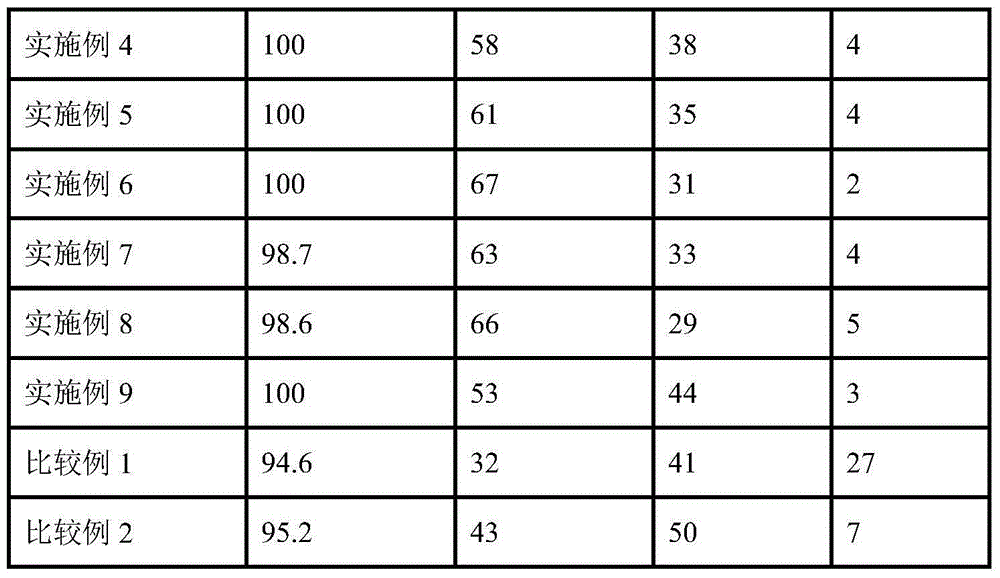Diacetylene hydrogenation catalyst
A hydrogenation catalyst and catalyst technology, which is applied in the direction of hydrogenation hydrocarbon production, physical/chemical process catalyst, metal/metal oxide/metal hydroxide catalyst, etc., can solve the problems of poor catalyst stability and high cost of alkyne hydrogenation
- Summary
- Abstract
- Description
- Claims
- Application Information
AI Technical Summary
Problems solved by technology
Method used
Image
Examples
Embodiment 1
[0017] Take by weighing 90 grams of pseudo-boehmite, 90 grams of θ-alumina, and 10 grams of turnip powder and mix evenly, then add 25 grams of polyvinyl alcohol solution (mass concentration is 5%), and 6.0 grams of nitric acid with a concentration of 68% , 1 g of magnesium nitrate, 310 ml of aqueous solution, squeezed into mm clover-shaped carrier, the wet strip was dried at 110° C. for 10 hours and then calcined at 980° C. for 4 hours to obtain the carrier. The carrier is impregnated in an equal amount of impregnation solution with a nickel content of 10wt.%, a zinc content of 0.1wt.%, and a lanthanum content of 0.1wt.%, dried at 60°C for 8 hours, and calcined at 450°C for 4 hours to obtain oxidized Ni The composition of the base catalyst is shown in Table 2. Then the catalyst was reduced for 12 hours under the conditions that the hydrogen pressure was 0.1 MPa, the temperature was 450° C. and the hydrogen flow rate was 1500 ml / min. When the temperature drops below 35° C., ...
Embodiment 2
[0019] Take by weighing 90 grams of pseudo-boehmite, 90 grams of θ-alumina, and 10 grams of turnip powder and mix evenly, then add 25 grams of polyvinyl alcohol solution (mass concentration is 5%), and 6.0 grams of nitric acid with a concentration of 68% , 2 grams of magnesium nitrate, 310 ml of aqueous solution, squeezed into mm clover-shaped carrier, the wet strip was dried at 110° C. for 10 hours and then calcined at 980° C. for 4 hours to obtain the carrier. The carrier is impregnated in equal amounts in an impregnating solution with a nickel content of 10wt.%, a zinc content of 0.5wt.%, and a cerium content of 0.5wt.%, dried at 60°C for 8 hours, and calcined at 450°C for 4 hours to obtain oxidized Ni The composition of the base catalyst is shown in Table 2. Then the catalyst was reduced for 12 hours under the conditions that the hydrogen pressure was 0.1 MPa, the temperature was 450° C. and the hydrogen flow rate was 1500 ml / min. When the temperature drops below 35° C....
Embodiment 3
[0021] Take by weighing 90 grams of pseudo-boehmite, 90 grams of θ-alumina, and 10 grams of asparagus powder and mix evenly, then add 25 grams of polyvinyl alcohol solution (mass concentration is 5%), and 5.0 grams of nitric acid with a concentration of 68% , 2 grams of calcium nitrate, 310 ml of aqueous solution, squeezed into mm clover-shaped carrier, the wet strip was dried at 110° C. for 10 hours and then calcined at 980° C. for 4 hours to obtain the carrier. The carrier is impregnated in equal amounts in an impregnating solution with a metallic nickel content of 12wt.%, a zinc content of 1.67wt.%, and a cerium content of 0.77wt.%, dried at 60°C for 8 hours, and calcined at 450°C for 4 hours to obtain an oxidized Ni-based substrate. The catalyst composition is shown in Table 2. Then the catalyst was reduced for 12 hours under the conditions that the hydrogen pressure was 0.1 MPa, the temperature was 450° C. and the hydrogen flow rate was 1500 ml / min. When the temperature...
PUM
 Login to View More
Login to View More Abstract
Description
Claims
Application Information
 Login to View More
Login to View More - R&D
- Intellectual Property
- Life Sciences
- Materials
- Tech Scout
- Unparalleled Data Quality
- Higher Quality Content
- 60% Fewer Hallucinations
Browse by: Latest US Patents, China's latest patents, Technical Efficacy Thesaurus, Application Domain, Technology Topic, Popular Technical Reports.
© 2025 PatSnap. All rights reserved.Legal|Privacy policy|Modern Slavery Act Transparency Statement|Sitemap|About US| Contact US: help@patsnap.com



